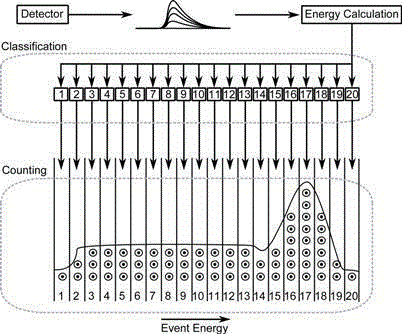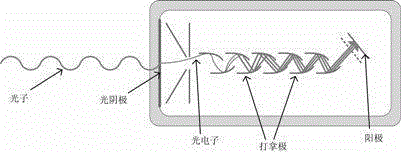Charged particles emitting decay detection method and apparatus
A detection method and technology of charged particles, applied in measuring devices, radiation measurement, X/γ/cosmic radiation measurement, etc., can solve the problem of not fully exploring angle, time, position, energy information, etc., and achieve high image signal-to-noise Ratio, the effect of reducing background noise
- Summary
- Abstract
- Description
- Claims
- Application Information
AI Technical Summary
Problems solved by technology
Method used
Image
Examples
example 1
[0058] The parameters for data processing in this embodiment are listed here:
[0059] The actual device used in step (1) is to use a black box with a size of 1.8m×1.8m×1.8m and a positron annihilation gamma photon 18F-FDG with a radiation source of 511kev. The measured object is a cylindrical phantom filled with FDG. A position-sensitive photomultiplier tube with enhanced red light is used, and the detector adopts a ring structure;
[0060] Step (2) The coincidence time is about 8 ns, and the coincidence judgment adopts offline time-energy coincidence processing;
[0061] Step (3) using the analytical charged emission decay event reconstruction method to directly plot the time and location of the charged emission event;
[0062] Step (4) uses the analytical nuclide distribution reconstruction method to directly plot the time and position of Cherenkov.
example 2
[0064] The parameters for processing data in this application instance 2 are listed here:
[0065] The actual device used in step (1) is to use a black box with a size of 1.8m×1.8m×1.8m and a 124I-NaI radiation source of 511kev. The measured object is a rat filled with 124I-NaI. Red light enhanced silicon photomultiplier tube, the detector adopts a square composed of four flat plates;
[0066] Step (2) The coincidence time is about 10ns, and the coincidence judgment adopts the online time coincidence processing;
[0067] Step (3) adopts the iterative charged emission decay event reconstruction method, and draws the time and position of Cherenkov by approximation;
[0068] Step (4) The iterative nuclide distribution reconstruction method is used to approximate the time and position of the charged emission event, and iterate until the relative change rate is less than 1%.
[0069] The method and device of the present invention can be used in nuclear technology that radiates ch...
PUM
 Login to View More
Login to View More Abstract
Description
Claims
Application Information
 Login to View More
Login to View More - Generate Ideas
- Intellectual Property
- Life Sciences
- Materials
- Tech Scout
- Unparalleled Data Quality
- Higher Quality Content
- 60% Fewer Hallucinations
Browse by: Latest US Patents, China's latest patents, Technical Efficacy Thesaurus, Application Domain, Technology Topic, Popular Technical Reports.
© 2025 PatSnap. All rights reserved.Legal|Privacy policy|Modern Slavery Act Transparency Statement|Sitemap|About US| Contact US: help@patsnap.com



